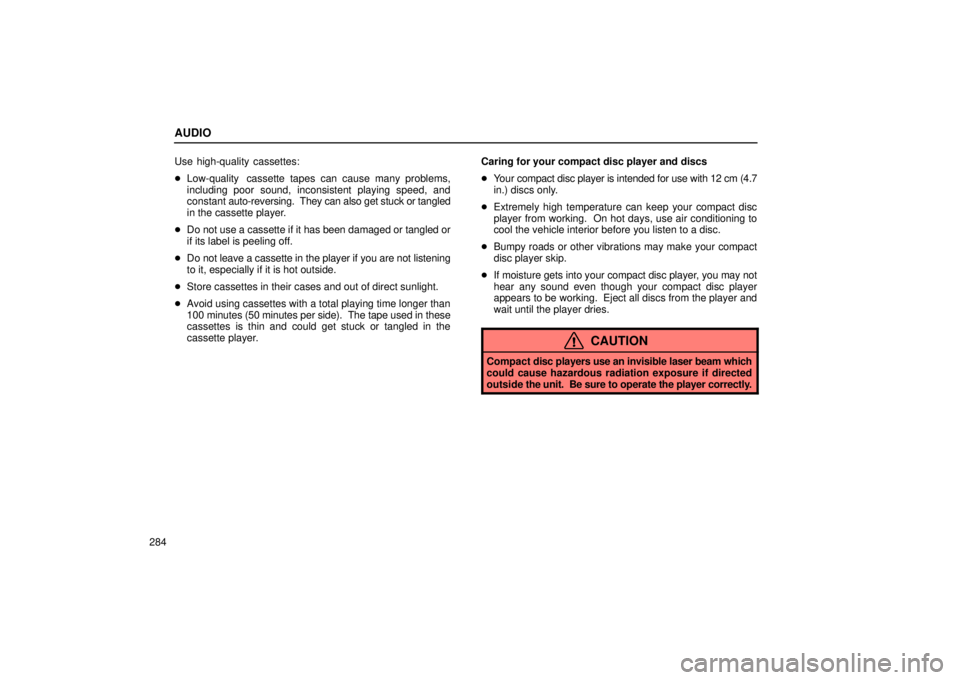Page 282 of 670
AUDIO
263
Automatic
sound levelizer: When the audio sound becomes
difficult to be heard due to road noise, wind noise, etc. during
driving, the system adjusts to the optimum volume and tone
quality according to the noise level. While the automatic sound
levelizer is on, ASLº appears on the display. (c) Your radio antennas
The wire antenna is mounted inside the quarter windows.
NOTICE
�When cleaning the inside of the quarter windows, be
careful not to scratch or damage the wire antennas or
connectors.
�Putting a window tint (especially, conductive or metallic type) on the quarter windows may affect thereception of radio or mobile telephone. For theinstallation of the window tint, consult with yourLexus dealer.
Page 302 of 670

AUDIO
283
Station swapping Ð If the FM signal you are listening to is
interrupted or weakened, and there is another strong station
nearby on the FM band, your radio may tune in the second
station until the original signal can be picked up again.
AM
Fading Ð AM broadcasts are reflected by the upper
atmosphere Ð especially at night. These reflected signals can
interfere with those received directly from the radio station,
causing
the radio station to sound alternately strong and weak.
Station interference Ð When a reflected signal and a signal
received directly from a radio station are very nearly the same
frequency, they can interfere with each other, making it dif ficult
to hear the broadcast.
Static Ð AM is easily affected by external sources of electrical
noise, such as high tension power lines, lightening, or electrical
motors. This results in static.
Caring for your cassette player and tapes
For the best performance for your cassette player and tapes:
Clean the tape head and other parts regularly.
� A dirty tape head or tape path can decrease sound quality
and tangle your cassette tapes. The easiest way to clean
them is by using a cleaning tape. (A wet type is
recommended.)
Page 303 of 670

AUDIO
284Use high-quality cassettes:
�
Low-quality cassette tapes can cause many problems,
including poor sound, inconsistent playing speed, and
constant auto-reversing. They can also get stuck or tangled
in the cassette player.
� Do not use a cassette if it has been damaged or tangled or
if its label is peeling off.
� Do not leave a cassette in the player if you are not listening
to it, especially if it is hot outside.
� Store cassettes in their cases and out of direct sunlight.
� Avoid using cassettes with a total playing time longer than
100 minutes (50 minutes per side). The tape used in these
cassettes is thin and could get stuck or tangled in the
cassette player. Caring for your compact disc player and discs
�
Your compact disc player is intended for use with 12 cm (4.7
in.) discs only.
� Extremely high temperature can keep your compact disc
player from working. On hot days, use air conditioning to
cool the vehicle interior before you listen to a disc.
� Bumpy roads or other vibrations may make your compact
disc player skip.
� If moisture gets into your compact disc player, you may not
hear any sound even though your compact disc player
appears to be working. Eject all discs from the player and
wait until the player dries.
CAUTION
Compact disc players use an invisible laser beam which
could cause hazardous radiation exposure if directed
outside the unit. Be sure to operate the player correctly.
Page 307 of 670
AUDIO
288
�Correct �Wrong
�Handle compact discs carefully, especially when you set
them into the player. Hold them on the edge and do not bend
them. Avoid getting fingerprints on them, particularly on the
shiny side.
� Dirt, scratches, warping, pin holes, or other disc damage
could cause the player to skip or to repeat a section of a
track. (To see a pin hole, hold the disc up to the light.)
To clean a compact disc: Wipe it with a soft, lint-free cloth
that has been dampened with water. Wipe in a straight line
from the center to the edge of the disc (not in a circle). Do not
use a conventional record cleaner or anti-static device.
Page 372 of 670
AUDIO
353
0126
Azerbaijani
0201Bashkir
0205Byelorussian
0207Bulgarian
0208Bihari
0209Bislama
0214Bengali
0215Tibetan
0218Breton
0301Catalan
0315Corsican
0319Czech
0325Welsh
0401Danish
0426Bhutani
0515Esperanto
0520Estonian
0521Basque
0601Persian
0609Finnish
0610Fiji
0615Faroese
Page 395 of 670

AUDIO
376Radio reception
Usually, a
problem with radio reception does not mean there is
a problem with your radio Ð it is just the normal result of
conditions outside the vehicle.
For example, nearby buildings and terrain can interfere with
FM reception. Power lines or telephone wires can interfere
with AM signals. And of course, radio signals have a limited
range. The farther you are from a station, the weaker its signal
will be. In addition, reception conditions change constantly as
your vehicle moves.
Here are some common reception problems that probably do
not indicate a problem with your radio:
FM
Fading and drifting stations Ð Generally, the effective range
of FM is about 40 km (25 miles). Once outside this range, you
may notice fading and drifting, which increase with the distance
from the radio transmitter. They are often accompanied by
distortion.
Multi-path Ð FM signals are reflective, making it possible for
two signals to reach your antenna at the same time. If this
happens, the signals will cancel each other out, causing a
momentary flutter or loss of reception.
Static and fluttering Ð These occur when signals are
blocked by buildings, trees, or other large objects. Increasing
the bass level may reduce static and fluttering. Station swapping Ð If the FM signal you are listening to is
interrupted or weakened, and there is another strong station
nearby on the FM band, your radio may tune in the second
station until the original signal can be picked up again.
AM
Fading Ð AM broadcasts are reflected by the upper
atmosphere Ð especially at night. These reflected signals can
interfere with those received directly from the radio station,
causing
the radio station to sound alternately strong and weak.
Station interference Ð When a reflected signal and a signal
received directly from a radio station are very nearly the same
frequency, they can interfere with each other, making it dif ficult
to hear the broadcast.
Static Ð AM is easily affected by external sources of electrical
noise, such as high tension power lines, lightening, or electrical
motors. This results in static.
Caring for your cassette player and tapes
For the best performance for your cassette player and tapes:
Clean the tape head and other parts regularly.
� A dirty tape head or tape path can decrease sound quality
and tangle your cassette tapes. The easiest way to clean
them is by using a cleaning tape. (A wet type is
recommended.)
Page 396 of 670

AUDIO
377
Use high-quality cassettes.
�
Low-quality cassette tapes can cause many problems,
including poor sound, inconsistent playing speed, and
constant auto-reversing. They can also get stuck or tangled
in the cassette player.
� Do not use a cassette if it has been damaged or tangled or
if its label is peeling off.
� Do not leave a cassette in the player if you are not listening
to it, especially if it is hot outside.
� Store cassettes in their cases and out of direct sunlight.
� Avoid using cassettes with a total playing time longer than
100 minutes (50 minutes per side). The tape used in these
cassettes is thin and could get stuck or tangled in the
cassette player.
Caring for your compact disc player, DVD player and discs
� Your compact disc player and DVD player are intended for
use with 12 cm (4.7 in.) discs only.
� Extremely high temperatures can keep your compact disc
player and DVD player from working. On hot days, use the
air conditioning to cool the vehicle interior before you use
the players.
� Bumpy roads or other vibrations may make your compact
disc player and DVD player skip. �
If moisture gets into your compact disc player and DVD
player, the players may not play even though they appear
to be working. Remove the disc from the player and wait
until it dries.
CAUTION
Compact disc players and DVD players use an invisible
laser beam which could cause hazardous radiation
exposure if directed outside the unit. Be sure to operate
the players correctly.
Page 401 of 670
AUDIO
382
�Correct�Wrong
�Handle compact discs carefully, especially when you are
inserting them. Hold them on the edge and do not bend
them. Avoid getting fingerprints on them, particularly on the
shiny side.
� Dirt, scratches, warping, pin holes, or other disc damage
could cause the player to skip or to repeat a section of a
track. (To see a pin hole, hold the disc up to the light.)
� Remove discs from the compact disc player when you are
not listening to them. Store them in their plastic cases away
from moisture, heat, and direct sunlight.
To clean a compact disc: Wipe it with a soft, lint-free cloth
that has been dampened with water. Wipe in a straight line
from the center to the edge of the disc (not in circles). Dry it with
another soft, lint-free cloth. Do not use a conventional record
cleaner or anti-static device.